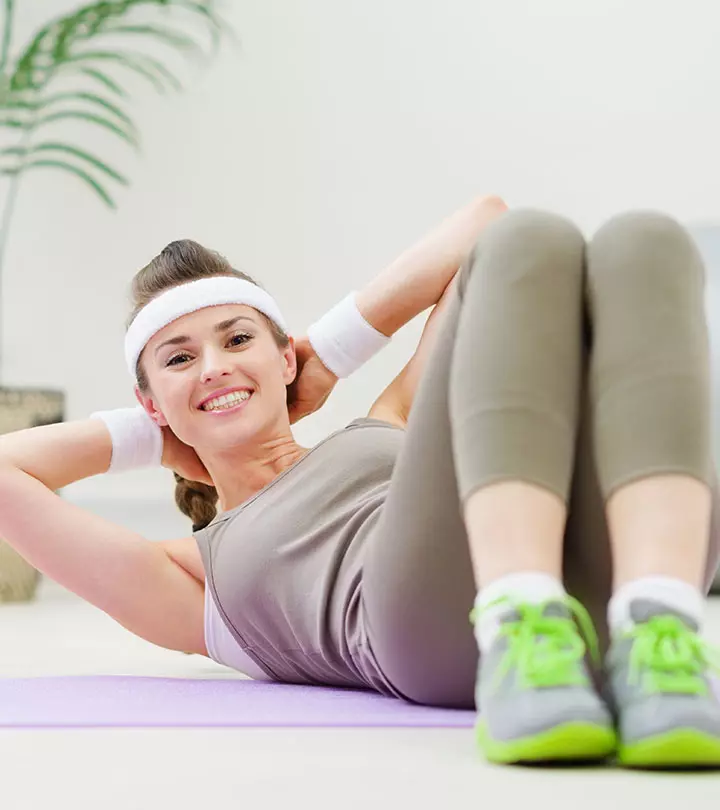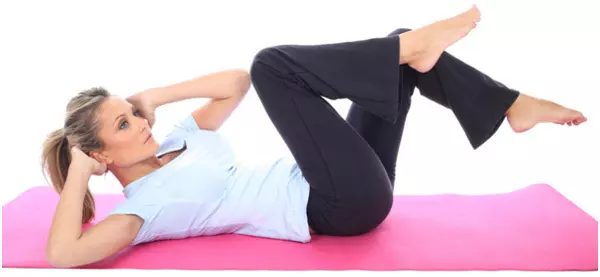6 Types Of Crunches, Benefits, How To Do, & Important Tips
Get those ripped abs of your dreams while targeting your core strength and muscles.

Image: ShutterStock
If you are someone familiar with the various kinds of exercises, you must be aware of the benefits of crunches as well! If not, fret not, we got you covered here! Crunches are abdominal exercises that mainly target your core muscles. Those chiseled 6-packs you see and adore are all a result of rigorous training that involves a variety of crunches, such as bicycle crunches, oblique crunches, twisted crunches, swiss ball crunches, and v-sit crunches along with other exercises. They are great core workouts that strengthen your core muscles with your own body weight. These work by flexing and releasing your core abdominal muscles helping lose fat and build lean muscle mass alongside. While they don’t need any specific equipment and can be done anywhere anytime, you can do crunches with weights as well!
A 2025 study analyzed the gender-based preference for fitness exercises in North Americans. It was a mixed-method study that involved 342 males and 327 females from the US and Canada. Overall, both males and females reported crunches to be one of their preferred exercises. 64.2% of males and 52.3% of females reported having a high perceived self-efficacy. Only 12.87% of males expressed concerns about doing crunches, as they found them strenuous for their bodies.
Imogen Rose, a YouTuber, took the challenge of doing 200 crunches every day for 7 weeks to understand the changes that it can do to the body. She stated, “Day one: I underestimated how hard this was going to be. My abs were burning the whole way through these first 200 (i).” She admits to having followed a diet plan and also some cardio exercises. By day 5 it got easier to do the crunches and the body got used to it, and by day 7 the stomach had toned down visibly. She added, “My stomach looks noticeably flatter than before.”
To know more about the benefits of crunches and how you should go about doing them, read on!
 Crunches
Crunches- Frequency: 2-3 times per week
- Benefits: Strengthen your core and improve mobility and flexibility.
- Equipment Needed: Exercise mat, dumbbells
- Space Required: Small area
- Assistance Required: No
- Who Should Avoid: Anyone with a history of back pain, spine problems, or neck issues and pregnant women
In This Article
Here Are Some Types Of Crunches, How To Do Them, And Their Benefits
Take a look at some core strengthening exercises that can give you a toned waistline.
1. The Basic Crunch:

The basic crunch is done by lying flat on your back with your knees bent and your hands behind your head, then you rise up to meet your pelvis using the shoulders and the core to maintain and propel you forward. Injuries can happen if you pull yourself forward on your neck or your head, using the strength of your hands. To avoid this risk, half crunches are a good place to start.
 Quick Tip
Quick Tip2. Reverse Crunch:

Reverse crunches are done by lying flat on your back and putting your leg up at 90 degrees like you do while doing leg raises. Place your hands facing the ground on either side of your body. If you are starting out, you can place your hands behind your hip for added support. Then, using your core muscles in a controlled manner; pull up your legs and hips towards the ceiling while bringing your knees towards your chest. Then return to the start position. During this exercise, try not to use too much momentum or to do it so fast that you hurt yourself. Repeat as many times as you can.
3. Vertical Leg Crunch:

To do vertical leg crunches, lie flat on your back with your arms straight. Lift your legs together and heels facing the ceiling till it is directly above your hips. Then raise your arms to almost touching the feet with your fingers while pulling in your belly button to stabilize your position using your ab muscles. Your torso will look almost like a U shape. Breathe slowly, control the movement and repeat for 8-15 reps.
4. Long Arm Crunches:

If you want more resistance you can keep your legs straight out. Your arms should be above your head. Clasp them together. Using your core muscles, lift the upper part of your body. Make sure not to strain your neck. Repeat it 8-15 times.
5. Bicycle Crunch:

This workout not only works the rectus abdominis but the upper abs as well. It is also one of the most effective oblique exercises. You can do this workout by lying flat on your back with your hands behind your head. Lift your knees off the floor towards your chest. First, rotate to the right and try to meet the left knee with the right elbow while you extend the right leg straight out, and then do the opposite side by trying to meet the right knee with the left elbow.
 Quick Tip
Quick Tip6. Double Crunches:

This is a basic crunch and reverse-crunch exercise together. Just lie on your back with your knees at a 90-degree angle and hands behind your head. Lift up your hips off the floor like in a crunch and lift up the shoulder blades off the floor like in a basic crunch. Try to squeeze the core and control the position. Then return to the start position.
It is always important to perform each of these exercises in the right way to avoid injuries. The next section covers some safety tips that you should be aware of.
Key Takeaways
- Crunches help strengthen abdominal muscles.
- They target the rectus abdominis muscle, also called the “six-pack muscle”.
- Crunches can help prevent lower back pain and improve one’s posture.
- It is essential to maintain a proper form and posture while performing crunches to avoid injuries.
Safety Tips For Performing Crunches
- Always do a quick warm-up to get your muscles ready.
- Don’t strain your neck while lifting any weight. Gently tuck in your neck for best results.
- Focus on using your abdominal muscles, not your back.
- Don’t push your neck or head with your hands. Keep them light on your head.
- Control your movements up and down, don’t rush through them.
- Keep your lower back pressed into the floor to avoid strain.
- If you feel pain (especially in your back or neck), stop and check your form.
- Make sure you exhale when you lift up, and inhale as you lower yourself back down.
Pros And Cons Of Doing Crunches
Pros
- Help prevent injuries and reduce back pain.
- Help enhance athletic performance by improving core strength and stability.
- Are easy to perform and do not require any special equipment.
- Improve balance and stability like any core exercise.
- Help reduce muscle pain and improve posture.
- Have several variations targeting different parts of the core that help break the monotony in your workout routine.
Cons
- Improper form can lead to injury (pulling your neck can strain your neck).
- Repeating the same form without any variation may lead to muscle imbalance and cause injury.
- Is not suitable for people with certain conditions like a herniated disc or lower back problems.
Infographic: Mistakes To Avoid While Doing Crunches
Crunches are one of the most popular exercises in abs training and they also improve flexibility and endurance. There are different variations of crunches that you can try at home. However, maintaining posture and following the right movements are crucial to avoid cramps and pains. Check out the infographic to know the common mistakes to avoid while doing crunches. Some thing wrong with infographic shortcode. please verify shortcode syntax
Crunches are the best to strengthen your core muscles, lose fat in the abdomen, and get well-defined six-pack abs. You don’t require any equipment to do these exercises. So, you can do them wherever you wish to, be it at home or outdoors. However, the key here is to maintain a good posture and form to avoid getting injured. Also, start with fewer reps and gradually increase the number as you feel comfortable. Complement this workout plan with a good diet to see the results for yourself in a few months.
Frequently Asked Questions
Is it healthy to do crunches every day?
Yes. Doing crunches every day is healthy and safe if you perform just a few sets.
Do crunches slim your waist?
Yes. Crunches and more specifically exercises like Russian twists, plank twists, and side plank crunches help tighten and tone the muscles around your abdomen, giving your stomach a flat look.
Which is better – plank or crunches?
Planks are better than crunches as they target a wider range of muscles and help build a stronger core from shoulders to glutes. Crunches are good for building ab muscles.
What is the best time to do crunches?
It is considered healthier to do crunches in the morning or before a meal to avoid the risk of back pain.
Which is harder – sit-ups or crunches?
Sit-ups activate more muscles than crunches and have a wider range of motion, making them comparatively harder.
How can I incorporate crunches into my workout routine?
You may include them in a well-rounded workout routine that also features other core exercises like planks and leg raises. Aim for 2-3 sets of 10-15 reps of different types of crunches, and combine them with cardio and strength training for overall fitness.
Calling all fitness beginners! Learn the right way to perform crunches. Get the best abs exercises with this fitness video. Take a look at the easy-to-follow guide in the video below to get fit and toned..
Personal Experience: Source
StyleCraze's articles are interwoven with authentic personal narratives that provide depth and resonance to our content. Below are the sources of the personal accounts referenced in this article.
(i) Realistic What 200 Ab Crunches A Day For A Week Did To Me | Before & After | Bali Series
https://www.youtube.com/watch?v=jQahgALo2Lc
Read full bio of Rakesh Rathod
Read full bio of Shirin Mehdi
Read full bio of Arshiya Syeda
Read full bio of Himanshi Mahajan


























Community Experiences
Join the conversation and become a part of our empowering community! Share your stories, experiences, and insights to connect with other beauty, lifestyle, and health enthusiasts.